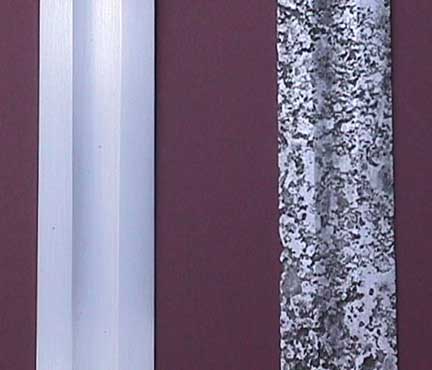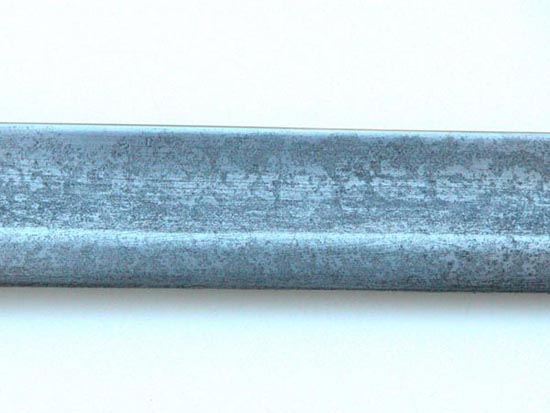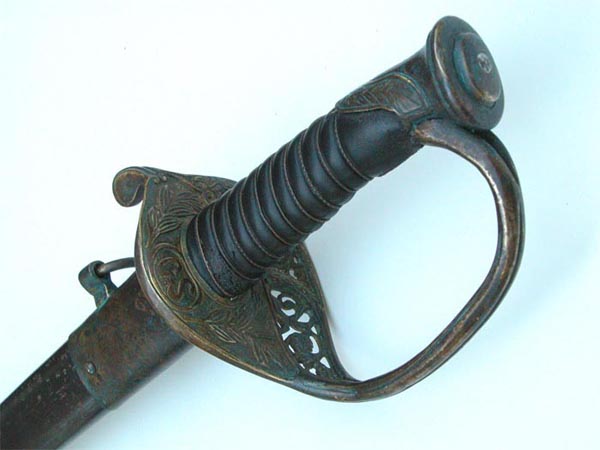As some of you might have noticed, I posted my Del Tin 2131 up on the classifieds, but didn't get any takers at the price I was asking. I decided that since it didn't sell I would continue my artificial aging techniques with a full sword. I have only done knives and a kettle helm in the past.
It took only a couple days to do, but there is legitimate pitting and not just staining like some techniques describe. I haven't decided what to do to the grip yet, but it looks a little out of place. I also think I will work on the quillons and pommel a bit more, but the blade is completed. Sean Flynt's article on the "instant antique" is quite good for those who want to do some basic aging, but my process degrades the material much further.
I wanted to go for the look of a sword that hung in a European church for hundreds of years and I think I have achieved that look. I don't want to specificially give away any of my techniques, but there are 4 seperate steps I do to include hydrochloric acid, mustard (which I have discussed on here in the past) and my "secret" bath that will achieve the pitting overnight.
Here is a before and after picture
[ Linked Image ]
Here is a picture of the full sword
[ Linked Image ]
[ Linked Image ]
...and here is a detailed picture of the blade showing the discoloration and more importantly, the pitting.
[ Linked Image ]
Mike
[ Linked Image ]
Mike
I'm thinking I might clean the blade up a little more so there is more shine to it and less discoloration, but the pitting will remain. This is the fourth piece I have done and probably the most expensive piece too. I was nervous at first, but since I don't use it for cutting and I want to add more antiques to my collection (which is hard to do when you can't afford them) I thought the next best thing was to make one.
Mike
Mike
Congratulations, great job.
Any info on the process or are you just keeping it a secret?
Any info on the process or are you just keeping it a secret?
Nice job.
Just a suggestion, maybe you could damage the edges some. A nick here, a blunt there, some edge wear. Show that the sword saw some hard use before being chucked in a chest somewhere to rust away the ages.
Just a suggestion, maybe you could damage the edges some. A nick here, a blunt there, some edge wear. Show that the sword saw some hard use before being chucked in a chest somewhere to rust away the ages.
| Bruno Giordan wrote: |
| Congratulations, great job.
Any info on the process or are you just keeping it a secret? |
Yeah, for now I am keeping my main technique secret. Flynt's article about the
http://www.myArmoury.com/feature_antique.html
is really great for working a light treatment. The vinegar and salt works well. However if you want something that wont run off, mustard works much better. I have been asked to do this for some people and since I would be making a little extra cash on it, I don't want to give away the secret....alteast not right now. If you dig online enough you can probably find out different things that work. The stuff I use to create the pitting involves a simple solution made from a couple things from the grocery store.
| Jonathan Blair wrote: |
| Nice job.
Just a suggestion, maybe you could damage the edges some. A nick here, a blunt there, some edge wear. Show that the sword saw some hard use before being chucked in a chest somewhere to rust away the ages. |
I was thinking about doing the damaged edge thing, but initially chose not to. If I do it now, I will have to re-age it. Yeah, it would only take another couple days, which isn't a big deal, but the solution tank I made takes up precious space in the garage and I can't park in there and have it going at the same time! :lol:
Mike
Ouch. Am I the only one who cringes at the sight of the heavy pitting inflicted on this sword? Personal taste and its your sword I know, but it pained me to see the damage inflicted. As for proposing edge damage, double ouch again.
I understand the goal you were going for and you certainly achieved it, but I personally wouldn't have gone so far. To me it seems you took a sword and decided to make it less valuable by going beyond mere antiquing finish to actual blade damage.
Not saying you didn't do a good job or shouldn't be able to do as you please with your sword, just that I was a bit saddened to see the extent of "distressing" done to a collectable sword. Hope everyone doesn't run out and do the same to their collection (absurd I know).
Well, to each their own.
Sorry to be negative, I am projecting I'm sure...
I understand the goal you were going for and you certainly achieved it, but I personally wouldn't have gone so far. To me it seems you took a sword and decided to make it less valuable by going beyond mere antiquing finish to actual blade damage.
Not saying you didn't do a good job or shouldn't be able to do as you please with your sword, just that I was a bit saddened to see the extent of "distressing" done to a collectable sword. Hope everyone doesn't run out and do the same to their collection (absurd I know).
Well, to each their own.
Sorry to be negative, I am projecting I'm sure...
I'm thinking of doing the same thing to my Del Tin- I mean it's just a Del Tin. Del Tin's are nice enough but I think make good canvasses for this type of thing.
Please be aware, folks, that salt and vinegar solution will pit the blade, given enough time to work. It should not be considered a "safe" (i.e., non-destructive) way to achieve antique effects. As I mentioned in my article, all these processes are destructive. Some simply work faster than others.
As for the concern about value--Raven Armoury ( http://www.raven-armoury.co.uk/ ) can convincingly put 1,000 years on a new sword, and the antiquing process used there commands a premium. I'm a big fan of the Raven approach of natural (but accelerated) distressing of the steel followed by careful conservation. Note that in the example shown here the edge was pristine when the work began. The edge irregularities of the final product are the result of corrosion rather than impact. Note also the meticulous conservation. The downside? Something like this can take years, apparently.
 Attachment: 23.6 KB
Attachment: 23.6 KB

As for the concern about value--Raven Armoury ( http://www.raven-armoury.co.uk/ ) can convincingly put 1,000 years on a new sword, and the antiquing process used there commands a premium. I'm a big fan of the Raven approach of natural (but accelerated) distressing of the steel followed by careful conservation. Note that in the example shown here the edge was pristine when the work began. The edge irregularities of the final product are the result of corrosion rather than impact. Note also the meticulous conservation. The downside? Something like this can take years, apparently.

Last edited by Sean Flynt on Thu 15 Mar, 2007 12:31 pm; edited 1 time in total
I think this demonstrates that there can be a life for swords that are no longer equal to our favorites, other than sale to a more junior collector. Your method could also provide a useful fate for a slightly damaged sword. I like the effect a lot, and am tempted to try something similar on one or two of my own Del Tins. It beats trying to live long enough to see the same result achieved naturally.
Steve Maly antiqued his Del Tin, too:
http://www.myArmoury.com/maly_swor_dt2153.html?12
It's a nice, subtle effect. Personally, I'd rub it down with fine steel wool and Ren Wax to remove the most superficial staining and red rust and brighten things up a bit. Looks great, though.
http://www.myArmoury.com/maly_swor_dt2153.html?12
It's a nice, subtle effect. Personally, I'd rub it down with fine steel wool and Ren Wax to remove the most superficial staining and red rust and brighten things up a bit. Looks great, though.
I never was able to get any pitting with the vinegar solution thats why I researched alternate methods, Sean. I will always love Del Tin. My first "real" sword came from them about 8 years ago. Terry, I can understand your feelings about the process, especially on something with more value. It took me awhile to finally decide to do it to this one. That's why I tried to sell it first. Although a "functional" sword, I never used it for that and it just hung on my wall mixed with replicas and antiques.
Since, realistically, I will never be able to afford a similar original, I wanted to make one. My interest in faked antiques all spawned about 8 years ago when I was deployed to Bosnia and on an R&R trip to Budapest I purchased an excavated dagger from a military antique shop there. It took me 6 years to get a positive answer on its origin by arranging a meeting with the arms and armor curator at the Met Museum in NY and he confirmed my thoughts about it being a fake.
Ever since then, I wanted to learn how this process of artificial aging and after a bit of research and tests on some small pieces was I able to determine the best course for me to take with a big piece. I enjoy doing it, but don't ever see myself doing it to something like an Albion or A&A unless someone wants me to do it to theirs.
I have done a few small pieces for people already and everyone seems to be pleased with the result. I suppose I could make a little extra money on the side doing it. It's kinda fun to see the process take place and to see the final results.
I am going to clean this one up, going back down to just the pitting and resoak it in the bath. Once I can get some more pitting I will give it a professional conservation look by cleaning the blade...yet again and I will be wrapping the hilt with some waxed twine I have.
I will post the final results here perhaps by the end of the weekend.
Mike
Since, realistically, I will never be able to afford a similar original, I wanted to make one. My interest in faked antiques all spawned about 8 years ago when I was deployed to Bosnia and on an R&R trip to Budapest I purchased an excavated dagger from a military antique shop there. It took me 6 years to get a positive answer on its origin by arranging a meeting with the arms and armor curator at the Met Museum in NY and he confirmed my thoughts about it being a fake.
Ever since then, I wanted to learn how this process of artificial aging and after a bit of research and tests on some small pieces was I able to determine the best course for me to take with a big piece. I enjoy doing it, but don't ever see myself doing it to something like an Albion or A&A unless someone wants me to do it to theirs.
I have done a few small pieces for people already and everyone seems to be pleased with the result. I suppose I could make a little extra money on the side doing it. It's kinda fun to see the process take place and to see the final results.
I am going to clean this one up, going back down to just the pitting and resoak it in the bath. Once I can get some more pitting I will give it a professional conservation look by cleaning the blade...yet again and I will be wrapping the hilt with some waxed twine I have.
I will post the final results here perhaps by the end of the weekend.
Mike
Here are a couple of recent projects with antique steel effects. The sword blade effects are from salt water alone. I used vinegar and salt for the halberd. In both cases, I sprayed the steel, let it rust for a day or two, cleaned it, sprayed it again waited another day or so, then cleaned and waxed. The steel is both stained and pitted in both cases. Since I discovered that plain salt water is the key to a convincing brass patina (spray before ammonia fuming,) as shown below, I've eliminated the vinegar so I can use one solution for everything.
 Attachment: 67.23 KB
Attachment: 67.23 KB

 Attachment: 17.25 KB
Attachment: 17.25 KB

 Attachment: 65.23 KB
Attachment: 65.23 KB




Last edited by Sean Flynt on Thu 15 Mar, 2007 1:02 pm; edited 2 times in total
Wow! I love the brass! I have yet to obtain a convincing brass patina. That is really nice!
Mike
Mike
| Michael Mercier wrote: |
| I have yet to obtain a convincing brass patina.
Mike |
The saltwater spray before fuming just makes all the difference in the world. It's easy to get an even darker finish than this, but I was trying to match some originals as closely as possible. What you see here is the result of two rounds of spraying-fuming-cleaning. The cleaning requires just the finest grade steel wool, a light touch and maybe some Ren Wax. I'll have much more to say/show about this project later. ;)
| Michael Mercier wrote: |
| I never was able to get any pitting with the vinegar solution
Mike |
Yeah, everybody gets different results, depending on the steel. Ditto for the brass. It seems that the unique composition of the metal can vary significantly enough that one person can get nothing much out of a method that works well for somebody else. Your experiments here and with mustard are very interesting, and prove that "all rivers lead to the sea."
| Michael Mercier wrote: | ||||
Yeah, for now I am keeping my main technique secret. Flynt's article about the http://www.myArmoury.com/feature_antique.html is really great for working a light treatment. The vinegar and salt works well. However if you want something that wont run off, mustard works much better. I have been asked to do this for some people and since I would be making a little extra cash on it, I don't want to give away the secret....alteast not right now. If you dig online enough you can probably find out different things that work. The stuff I use to create the pitting involves a simple solution made from a couple things from the grocery store.
I was thinking about doing the damaged edge thing, but initially chose not to. If I do it now, I will have to re-age it. Yeah, it would only take another couple days, which isn't a big deal, but the solution tank I made takes up precious space in the garage and I can't park in there and have it going at the same time! :lol: Mike |
This is because I'm impressed by the pitting you get in just two days.
I guess that adding a burying in a dung heap + mustard + various acidic things added will reduce a sword to an archeological find in a reasonable amount of time.
The reason I'm asking is in this swordforum thread.
http://forums.swordforum.com/showthread.php?p...post895870
A famous german museum curator who was one of the best numismatic expert of his age (XVIII century) turned out also to be one of the best fakers after his death.
His method?
After minting his new roman coins he would attach them to the axis of a chariot and let them get dirt and scratches plus weathering for months, then another period in the manure heap.
His method?
After minting his new roman coins he would attach them to the axis of a chariot and let them get dirt and scratches plus weathering for months, then another period in the manure heap.
| Bruno Giordan wrote: |
| After minting his new roman coins he would attach them to the axis of a chariot and let them get dirt and scratches plus weathering for months, then another period in the manure heap. |
Ha! Your secret is out, Mike!
Page 1 of 2
You cannot post new topics in this forumYou cannot reply to topics in this forum
You cannot edit your posts in this forum
You cannot delete your posts in this forum
You cannot vote in polls in this forum
You cannot attach files in this forum
You can download files in this forum
All contents © Copyright 2003-2006 myArmoury.com — All rights reserved
Discussion forums powered by phpBB © The phpBB Group
Switch to the Full-featured Version of the forum
Discussion forums powered by phpBB © The phpBB Group
Switch to the Full-featured Version of the forum